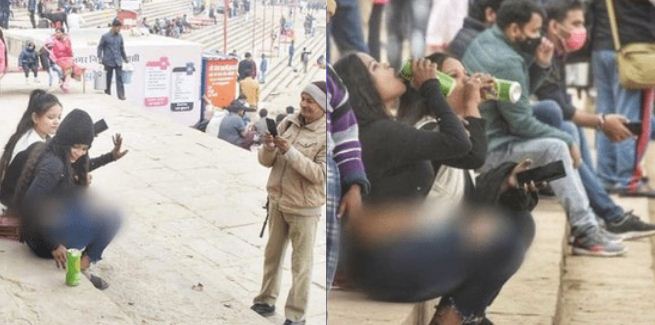At the start of 2022, a picture of a girl allegedly drinking beer at the Assi Ghat in Varanasi became a talking point on social media. Apart from the chatter on social media, there is an important issue that needs to be discussed- religious tourism.
Teerth is being promoted as a tourist activity and matter of showbiz. But it isn’t really in line with the real concept of Teerth, which is central to Hinduism.
Make these girls famous , celebrating New year on #AssiGhat on the banks or Maa Ganga in #Banaras …as if it is pub. This is what cultural degradation looks like, when woke think of Mandir as Selfie point and talk of 'Trip To Kedarnath' as if some holiday spot. pic.twitter.com/aNpQz8aZEe
— Hindu Urjaa (@HinduUrjaa) January 2, 2022
What does Teerth mean?
Teerth is all about the purity of soul and body. You are actually supposed to take pains to travel to an ancient sacred institution, including the ones located in extremely remote areas like Badrinath and Kedarnath. And it is nothing about leisure or merrymaking.
The fundamental reason and the driving force behind Teerth is a strong belief. There has to be a strong spiritual urge that makes an individual travel long distances and seek purity of mind and soul.
What is tourism?
This is really an elementary question. I mean we all know what tourism is. There is not much to describe here.
The thing about tourism is that it is more about leisure and creating a carefree atmosphere. Tourists want to have a good time and therefore they decide to go to a popular, crowded destination.`
For millennials, tourism is also becoming a tool for escaping the stressful urban life and polluted concrete jungles that present-day cities have become. This is why you can find ‘off-beat’ destinations dotted all across the country. These ‘off-beat’ destinations are becoming care-free spots frequented by overstressed individuals for relaxing themselves and ‘having a good time’.
For the State, tourism becomes important. It is a source of revenue for administrations and also boosts local economies. Tourists bring along their money that stimulates the growth of the hospitality sector and improves employability. And there is not much regard for the purity of the place, rather a conducive environment is supposed to be created for the incoming tourists.
Tourism v Teerth
Teerth and tourism are poles apart. The only similarity between Teerth and tourism is perhaps the travelling involved. Teerth sthals (pilgrimage spots) are not supposed to be reduced into picnic spots. They represent the living deity and there are some strict rules involved for such a holy site where the human conscience is supposed to coalesce with the almighty.
Unlike tourism, Teerth is supposed to be done with some strict rules. You are not supposed to do what you like. In fact, the way you conduct yourself, that is, acharan, forms the basic structure of a Teerth.
Yet, you can observe how Teerth is getting reduced to tourism all over the country. With thousands of travellers flocking teerth sthals like Vaishno Devi, Badrinath and Kedarnath, you can be sure about one thing- not all the travellers are driven by spiritual desire. For many tourists, pilgrimage sites are becoming some of the many ‘offbeat’ venues and exotic tourist spots to visit and relax. In the process, the holy concept of Teerth is getting violated.































